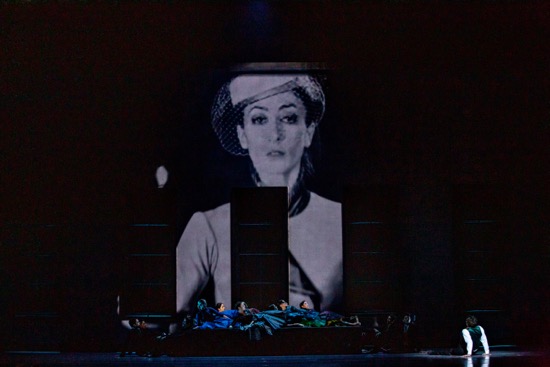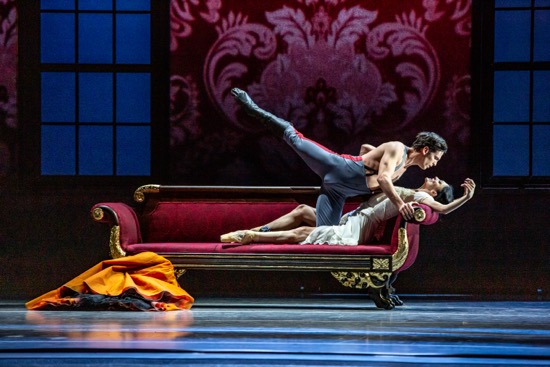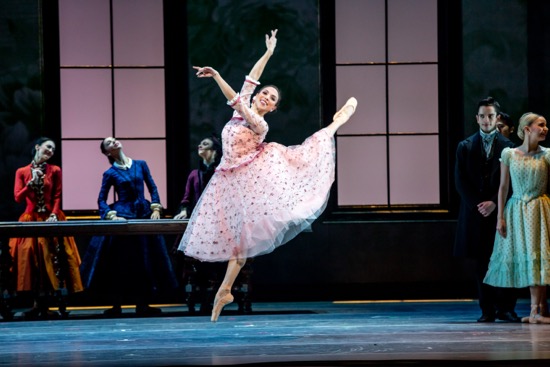
by Luis Eduardo Gonzalez
Anna Karenina premiered this past Wednesday at the Auditorium Theatre. The story was originally written by Leo Tolstoy in 1878, and been adapted into various media including opera, film, television, ballet, figure skating and radio drama. Yuri Possokhov took on the task of doing it for himself and as far as I’m concerned excelled. There is always more excitement as well as stress with a world premiere rather than something that has already been choreographed. There are so many aspects to work out in terms of production and seeing what does and doesn’t work on the stage, but what I have found most interesting is the way that Yuri has been able to simplify one of the most nuanced and complicated novels to fit a ballet setting without losing the essence of the story or the message that I think was originally intended by Tolstoy. The clarity that comes with having to simplify a story as nuanced as Tolstoy’s for the sake of something that works on screen or on a stage is that it makes it easier to draw the parallels and, in a way, draw a more profound correlation between the message of the story and life. The beauty of a masterpiece like Anna Karenina is that someone like Tolstoy spent most of his life writing this to articulate his thoughts and social commentary on the world around him. Having read the book, and seen a few of the movies I think specifically for us as dancers there may be more to learn from this story than initially meets the eye.

All of the characters in the book are nuanced to the point where the reader can clearly follow their thought patterns and in some ways understand even their most erratic decisions. The beauty with the simplification of the story for a ballet or movie and the loss of some of the nuance is that one can see with a bit more perspective. This vantage point allows an audience to see that that some of those choices were made because the characters were lacking that very perspective. They were too consumed with idiosyncrasies in their lives and giving too much value to too many things, which often left them feeling empty and dissatisfied in many aspects of their lives. Women during Anna’s time were decidedly oppressed in many ways. The level of agency that they were allowed by men around them was extremely limited and obviously that had a lot to do with Anna’s difficulties in life. Having said that, Anna was a woman who in comparison to other women of her time had it all. She had social standing, money, a family, friends, and the support of her husband in almost any venture she so desired (except the very public pursuit of another man). Still somewhere along the line, she decided it wasn’t enough. She was swept away by the excitement of passion with someone new, someone that could give her that initial feeling of a spark and of fire (which she also eventually tired of) that she felt was missing from her otherwise full life. She gave so much value to the spark of passion that she was willing to give up everything else for it.
The way I read it, the book has two main story lines; Kitty, and Anna. Kitty falls for the excitement of passion, even though she had someone who really loved her. What she really wanted was true love, but she was blinded by the excitement of a good looking man in uniform which is what she believed she needed. When she realizes that the pretty smile and the uniform were hiding empty promises, she goes back to the man who after everything, still loved her and lives happily ever after. Unlike Kitty, Anna gives up her social status, her husband, and even her child for the sake of chasing passion with Vronsky, and even that passion eventually fades. Even the effects of Morphine were not enough to fill the emptiness that Anna was dealing with after she gave all the value she had within her to chasing empty highs, eventually leading Anna to take her own life.

There is a very basic principle in eastern philosophy which deals with the values that you assign to things. A book recently came out in the united states called The Subtle Art of Not Giving a F*@K which largely deals with this principle only interpreted for a western audience. The author Mark Manson has a quote which I found interestingly relevant to this story “The desire for more positive experience is itself a negative experience. And, paradoxically, the acceptance of one’s negative experience is itself a positive experience.” This quote applies to the story as well as to our perceptions of ourselves as dancers. The Dalai Lama actually also says something very similar in a recent release The Book of Joy “We create most of our suffering, so it should be logical that we also have the ability to create more joy. It simply depends on the attitudes, the perspectives, and the reactions we bring to situations and to our relationships with other people. When it comes to personal happiness there is a lot that we as individuals can do.” What this says to me is that suffering is in some ways inevitable, we can however chose how we react to that suffering by recalibrating and maybe simplifying the things that we give value to and what our initial motivations were to begin with.
The way that I feel all this correlates with our trajectories as dancers goes back to the reason why any of us started dancing in the first place. Weather your mom put you in classes at three or you decided you wanted to do it at thirteen we all eventually decided to stick with it because we felt a connection with the art form. Once we got into the swing of things, we were eventually inundated with the outpouring of information from Instagram, YouTube and Dance magazine, telling us what lives should look like, what our careers should look like, what our salaries should look like, what our bodies should look like, in order to feel “successful”. These definitions of success are essentially selling us an idea of what our happiness should look like. As wonderful as it is that all these sources celebrate some people’s versions of success, taking these edited depictions as our own metrics for happiness deprives us of finding joy in the day to day beauty of the nuances that come with pursuing a career in dance, the accomplishments we make and in maintaining that connection with the art form that drew us to make the decision to spend our lives doing what we do.

I believe that mental health is something that is under-addressed in our field, but I think the assignment of value to things that steal our joy is a problem for anyone who is living in the world today. Being unaware, and consequently unable to simplify our metrics for the things that really matter to us is in my opinion, one of the leading causes for the massive percentage of dancers who struggle with mental health disorders. People in our field struggle with self-esteem, anxiety, eating disorders, depression among others and it all comes back to not feeling good enough. Aside from it detracting from our ability to experience joy through our careers, I would also go as far as to say that it actually prevents us from focusing on what we actually have to work with and improving on it. The time spent suffering because what you look like, or what you have is not good enough is time that could be spent on developing the most fully realized version of what you do have. Generally speaking, “successful” people are able to accomplish more and are magnetizing because they spend their time exploring their own potential instead of trying to mimic someone else’s.
I think in our community it’s so easy to think of your identity being irrevocably entwined with being a dancer, but we are in fact people who dance. As people we have to make sure that our basic needs are being taken care of, with mental health being a key component of that. We must realize that if one is lucky enough to make a livelihood pursuing something as uncommon and passion driven as dance, it is so incredibly short sided to allow someone else’s magazine cover or YouTube video deprive you of the pursuit for a deeper connection with the art form. Giving more value to empty desires like fame, more money than you need to live comfortably, validation from likes on a photo, or just the temporary high of feeling like you’re “better” than someone else, will leave you feeling empty because it robs you of the ability to give that value to what really matters which is your connection with the art form. I’m not saying that it will inevitably lead you to Anna’s unfortunate demise, but mental health is not something to be taken lightly, and I think Anna’s story serves as a cautionary tale for being unable to recalibrate personal metrics for happiness for too long.

Contributor Luis Eduardo Gonzalez joined The Joffrey Ballet in July 2015.
Mr. Gonzalez, is originally from Bogota, Colombia, where he grew up before moving to Atlanta, Georgia. His training came primarily from the continued direction of Maniya Barredo, former prima ballerina of Atlanta Ballet, and current director of Metropolitan Ballet Theatre. Mr. Gonzalez has received the Star Student award at Regional Dance America’s SERBA, been awarded 3rd place at the Regional Youth American Grand Prix competition in 2008, given first place pas de deux at the American Ballet Competition in 2013, and selected to compete as the only representative of Colombia in the 2014 Jackson International Ballet Competition.
Mr. Gonzalez began his professional career with The Houston Ballet II, where he had the opportunity to dance works by Stanton Welch, among other renowned choreographers, as well as tour both nationally and internationally. At 18, he joined Orlando Ballet where he danced for three years and performed roles such as the Jester in Swan Lake, Peter in Peter and the Wolf, Ghoul’s trio in Vampire’s Ball, Franz’s friend in Coppelia, and Cavalier in the Sugar Plum Pas de deux in The Nutcracker.





I feel that this is SUCH an important subject to touch on…. I’ve experienced that very struggle at the early stages of my teaching career, which I am navigating as we speak: so often I find the original and authentic joy that dance holds for me being drowned out by other things that aren’t important. Thank you for bringing our attention back to the fact that artists who are doing what they love are allowed to acknowledge that they aren’t ALWAYS happy. That way, we can address the reasons for that and move forward with loving our art form and the process again!
Thanks for your comment. So much to navigate in this career! 🙂 Appreciate you taking the time to read this.